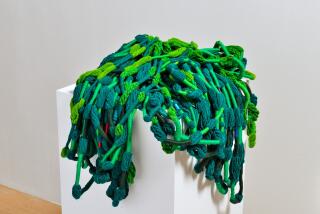Review: Rodney McMillian on the puppets of politics
The shape of Rodney McMillian’s new exhibition at Susanne Vielmetter is a U-turn. It feels scattered on first pass, but comes together on the return trip.
Parsed out across all four of the gallery’s sequential rooms are paintings, found drawings, videos and a textile piece. The show is about Ronald Reagan’s 1980 presidential campaign, but like most historical efforts, it’s really a mirror held up to present realities.
Viewers are greeted by a monumental, 45-foot long abstract painting that undulates across the entirety of the first gallery. Titled “Representation of a Landscape as a Wall,” it’s Jackson Pollock on steroids, splattered with sticky-looking black pours and skeins of red, gray and blue. It exerts a glacial pressure on the space, but it’s not clear to what end.
The next room features a video projection of a ventriloquist’s dummy enacting a 1980 campaign speech that Reagan delivered at the Neshoba County Fair in Mississippi. Hanging on the wall across from the projection is an “audience” of found portraits, created by little known midcentury Southern artist Horace Taylor. The use of the “dummy” as a comment on Reagan’s spiel is clear, as is the anachronistic portrait of his audience, but why is the speech followed by a dinosaur puppet singing an ambivalent romantic lament by Erykah Badu?
The dummy appears again in a video in the following room, sitting on a porch swing with another puppet. The soundtrack is from a 1981 interview with Republican strategist Lee Atwater, in which he explains how Reagan’s language of fiscal conservatism and tax cuts is actually the evolution — a coded version — of an earlier, starkly racist appeal to poor Southern whites. Although the puppets’ mouths aren’t moving, the piece exposes a more sinister kind of ventriloquism that feels uncomfortably familiar.
Across from this tableau hangs a poignant, perverted American flag in which the rectangle that usually bears the stars is a shiny black piece tacked onto a burlap background. The “stripes” are words, embroidered in red, from a man imprisoned for drug possession. He finds it ironic that despite marching for voting rights in the 1960s and serving in Vietnam, he is now, because of his conviction, ineligible to vote. The piece quietly reveals how Reagan’s war on drugs was (and is) actually a coded campaign for disenfranchisement.
The final room contains a video of a masked man carrying an ax through the grounds of a Southern plantation. It supposedly uses the language of horror films to comment on slavery reparations, but doesn’t quite get there. Still, it serves as a kind of bookend to the painting in the front room, recasting the language of abstract splatters into something much more literal and monstrous.
Tracking back through the galleries, one begins to see how these disparate parts are really one fretful story, moving forward from slavery to civil rights, and then backward (covertly) from civil rights to the war on drugs. Connections could also be made to the war on terror, with its disproportionate toll on poor, black and brown lives. Perhaps the Badu song, caught as it is between love and disgust, is actually a fitting anthem.
Susanne Vielmetter Los Angeles Projects, 6006 Washington Blvd., Culver City, (310) 837-2117, through Feb. 23. Closed Sundays and Mondays. www.vielmetter.com
More to Read
The biggest entertainment stories
Get our big stories about Hollywood, film, television, music, arts, culture and more right in your inbox as soon as they publish.
You may occasionally receive promotional content from the Los Angeles Times.










